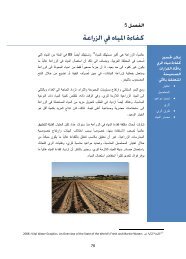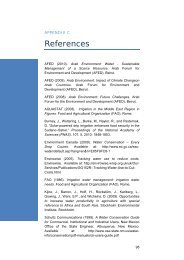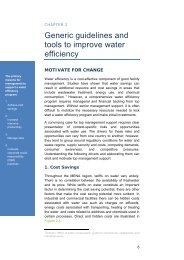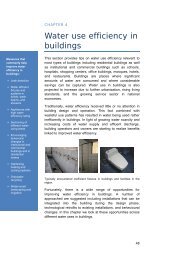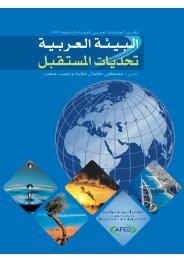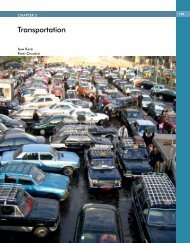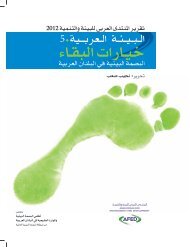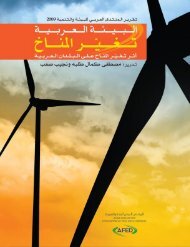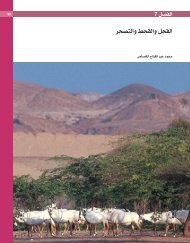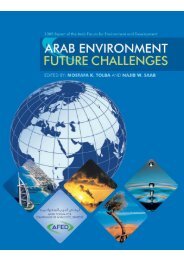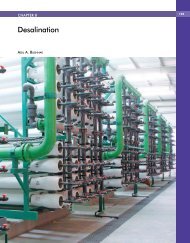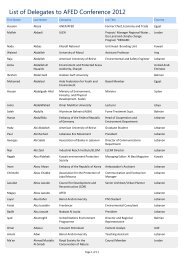Impact of Climate Change on Arab Countries - (IPCC) - Working ...
Impact of Climate Change on Arab Countries - (IPCC) - Working ...
Impact of Climate Change on Arab Countries - (IPCC) - Working ...
Create successful ePaper yourself
Turn your PDF publications into a flip-book with our unique Google optimized e-Paper software.
116<br />
CHAPTER 9<br />
INFRASTRUCTURE<br />
from 0.5 to 1.4 meters; with some studies showing<br />
that melting from ice sheets al<strong>on</strong>e could cause<br />
SLR <str<strong>on</strong>g>of</str<strong>on</strong>g> up to 2 meters. Not <strong>on</strong>ly would SLR<br />
result in the inundati<strong>on</strong> <str<strong>on</strong>g>of</str<strong>on</strong>g> highly populated and<br />
productive areas, but it would also accentuate the<br />
impact <str<strong>on</strong>g>of</str<strong>on</strong>g> sea surges leading to beach degradati<strong>on</strong>,<br />
erosi<strong>on</strong> <str<strong>on</strong>g>of</str<strong>on</strong>g> road bases, instability <str<strong>on</strong>g>of</str<strong>on</strong>g> bridges<br />
and harbour structures, in additi<strong>on</strong> <str<strong>on</strong>g>of</str<strong>on</strong>g> posing<br />
serious hazards to coastal populati<strong>on</strong>.<br />
These projecti<strong>on</strong>s could have dire c<strong>on</strong>sequences<br />
for the <strong>Arab</strong> world c<strong>on</strong>sidering the c<strong>on</strong>centrati<strong>on</strong><br />
<str<strong>on</strong>g>of</str<strong>on</strong>g> very significant proporti<strong>on</strong>s <str<strong>on</strong>g>of</str<strong>on</strong>g> populati<strong>on</strong> and<br />
ec<strong>on</strong>omic assets in coastal z<strong>on</strong>es in the major<br />
cities such as Alexandria, Casablanca, Algiers,<br />
Tripoli, Tunis, Beirut, Latakia, Jidda, Basra,<br />
Kuwait city and Dubai. In a study by the<br />
Organizati<strong>on</strong> for Ec<strong>on</strong>omic Co-operati<strong>on</strong> and<br />
Development (OECD) (Nicholls et al., 2008)<br />
Alexandria was currently ranked 9 th in terms <str<strong>on</strong>g>of</str<strong>on</strong>g><br />
exposed populati<strong>on</strong> (1.33 milli<strong>on</strong>) and 17 th in<br />
terms <str<strong>on</strong>g>of</str<strong>on</strong>g> exposed assets ($28.46 billi<strong>on</strong>) am<strong>on</strong>g<br />
the world’s portal cities. By 2070, the city is projected<br />
to be in the 11 th place in terms <str<strong>on</strong>g>of</str<strong>on</strong>g> exposed<br />
populati<strong>on</strong> (4.38 milli<strong>on</strong>) and 20 th in terms <str<strong>on</strong>g>of</str<strong>on</strong>g><br />
exposed assets ($563.28 billi<strong>on</strong>).<br />
Despite the gravity <str<strong>on</strong>g>of</str<strong>on</strong>g> this situati<strong>on</strong> there are very<br />
few studies carried out assessing the impact <str<strong>on</strong>g>of</str<strong>on</strong>g><br />
SLR in the <strong>Arab</strong> regi<strong>on</strong> (e.g., AFED, 2008: 129-<br />
131). One <str<strong>on</strong>g>of</str<strong>on</strong>g> these studies (El Raey et al., 1999)<br />
provided an assessment <str<strong>on</strong>g>of</str<strong>on</strong>g> the impact <str<strong>on</strong>g>of</str<strong>on</strong>g> SLR <strong>on</strong><br />
the two main coastal directorates in Egypt:<br />
Alexandria and Port Said. Current c<strong>on</strong>diti<strong>on</strong>s<br />
and those for 0.25, 0.5 and 1 meter projected<br />
SLR were assessed. The study shows that these<br />
areas are highly vulnerable to SLR with the<br />
potential <str<strong>on</strong>g>of</str<strong>on</strong>g> forcing milli<strong>on</strong>s to permanently<br />
migrate out and result in losses in the billi<strong>on</strong>s <str<strong>on</strong>g>of</str<strong>on</strong>g><br />
dollars to urban dwellings, recreati<strong>on</strong>al facilities,<br />
industrial assets and infrastructure.<br />
Al-Jeneid et al. (2008) assessed the impact <str<strong>on</strong>g>of</str<strong>on</strong>g><br />
SLR <strong>on</strong> Bahrain’s archipelago. SLR <str<strong>on</strong>g>of</str<strong>on</strong>g> 0.5, 1, 1.5,<br />
2 and 5 meters were c<strong>on</strong>sidered. The findings<br />
underscore the vulnerability <str<strong>on</strong>g>of</str<strong>on</strong>g> Bahrain to SLR<br />
even for the lower SLR <str<strong>on</strong>g>of</str<strong>on</strong>g> 0.5 meters. This is<br />
mainly attributed to the c<strong>on</strong>centrati<strong>on</strong> <str<strong>on</strong>g>of</str<strong>on</strong>g> populati<strong>on</strong><br />
and commercial and industrial activities in<br />
the coastal areas. In particular, key industrial and<br />
commercial parks and infrastructure including<br />
main roads and highways are situated in lowlying<br />
newly reclaimed areas.<br />
One <str<strong>on</strong>g>of</str<strong>on</strong>g> the dilemmas facing policy makers in<br />
dealing with the impact <str<strong>on</strong>g>of</str<strong>on</strong>g> SLR is striking a balance<br />
between the costly investment in developing<br />
and maintaining coastal protecti<strong>on</strong> works <strong>on</strong> the<br />
<strong>on</strong>e hand and the difficulty in c<strong>on</strong>trolling and<br />
reversing urban and industrial growth in coastal<br />
areas <strong>on</strong> the other. For instance, it is deemed prohibitively<br />
expensive and socially disruptive to



